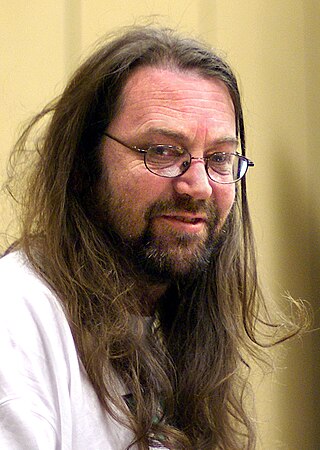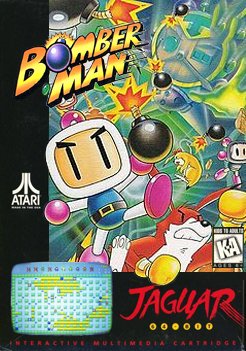
The Atari Jaguar is a home video game console developed by Atari Corporation and released in North America in November 1993. Part of the fifth generation of video game consoles, it competed with the 16-bit Sega Genesis, the Super NES and the 32-bit 3DO Interactive Multiplayer that launched the same year. Powered by two custom 32-bit processors – Tom and Jerry – in addition to a Motorola 68000, Atari marketed it as the world's first 64-bit game system, emphasizing its 64-bit bus used by the blitter. The Jaguar launched with Cybermorph as the pack-in game, which received divisive reviews. The system's library ultimately comprised only 50 licensed games.
The Konix Multisystem was a cancelled video game system under development by Konix, a British manufacturer of computer peripherals.
Martin Brennan is a computer engineer who developed pioneering personal computers such as the Loki and the Atari Jaguar video game console.

Jeff Minter is an English video game designer and programmer who often goes by the name Yak. He is the founder of software house Llamasoft and has created dozens of games during his career, which began in 1981 with games for the ZX80. Minter's games are shoot 'em ups which contain titular or in-game references demonstrating his fondness of ruminants. Many of his programs also feature something of a psychedelic element, as in some of the earliest "light synthesizer" programs including Trip-a-Tron.
Flare Technology was a computer hardware company based in Cambridge, United Kingdom. It was founded in 1986 by Martin Brennan, Ben Cheese, and John Mathieson, former engineers at Sinclair Research.
The Motorola 68000 series is a family of 32-bit complex instruction set computer (CISC) microprocessors. During the 1980s and early 1990s, they were popular in personal computers and workstations and were the primary competitors of Intel's x86 microprocessors. They were best known as the processors used in the early Apple Macintosh, the Sharp X68000, the Commodore Amiga, the Sinclair QL, the Atari ST, the Sega Genesis, the Capcom System I (Arcade), the AT&T UNIX PC, the Tandy Model 16/16B/6000, the Sun Microsystems Sun-1, Sun-2 and Sun-3, the NeXT Computer, NeXTcube, NeXTstation, and NeXTcube Turbo, the Texas Instruments TI-89/TI-92 calculators, the Palm Pilot and the Space Shuttle. Although no modern desktop computers are based on processors in the 680x0 series, derivative processors are still widely used in embedded systems.
Ben Cheese was a British engineer who worked on Sinclair's ZX Microdrives. Authors Ian Adamson and Richard Kennedy, in their book Sinclair and the "Sunrise" Technology, write that "it seems only fair to note that it was the tenacity and imagination of R&D staffer Ben Cheese that got the product [i.e., the Microdrive] to the market".

The Atari Panther was the design codename for a cancelled video game console from Atari Corporation planned as the successor to the Atari 7800 and the Atari XEGS. It was developed by Flare Technology, the same ex-Sinclair team who worked on the cancelled Flare One and Konix Multisystem consoles.
Cray Inc., a subsidiary of Hewlett Packard Enterprise, is an American supercomputer manufacturer headquartered in Seattle, Washington. It also manufactures systems for data storage and analytics. Several Cray supercomputer systems are listed in the TOP500, which ranks the most powerful supercomputers in the world.
This article presents a timeline of events in the history of computer operating systems from 1951 to the current day. For a narrative explaining the overall developments, see the History of operating systems.

A graphics processing unit (GPU) is a specialized electronic circuit initially designed to accelerate computer graphics and image processing, but have later been used for non-graphic calculations involving embarrassingly parallel problems due to their parallel structure. Other non-graphical uses include the training of neural networks and cryptocurrency mining.
Loki was the code name for a cancelled home computer developed at Sinclair Research during the mid-1980s. The name came from the Norse god Loki, god of mischief and thieves. Loki was based on the ZX Spectrum, but intended to rival the Amiga for video games.

VM Labs was a semiconductor and platform company, founded in 1995 in Los Altos, Silicon Valley, California.
Atari Corporation was an American manufacturer of computers and video game consoles. It was founded by Jack Tramiel on May 17, 1984, as Tramel Technology, Ltd., but then took on the Atari name less than two months later when Warner Communications sold the home computing and game console assets of Atari, Inc. to Tramiel. Its chief products were the Atari ST, Atari XE, Atari 7800, Atari Lynx and Atari Jaguar.

Fight for Life is a 1996 fighting video game developed and published by Atari Corporation in North America and Europe for the Atari Jaguar. It was the final game to be developed and published by Atari themselves before dropping support for the platform and merging with JT Storage in a reverse takeover on July 30, 1996, and the last fighting title released for the console. Set in a purgatory dimension known as the Specter Zone, Fight for Life follows eight deceased fighters as they enter a tournament held by a shapeshifting being called the Gatekeeper, who will bestow a second chance at life to the winning victor. Its gameplay consists of one-on-one fights, with a main eight-button configuration, featuring special moves and the ability to customize character's movesets, as well as four different playable modes.
This article covers the History of CP/CMS — the historical context in which the IBM time-sharing virtual machine operating system was built.

Arm is a British semiconductor and software design company based in Cambridge, England whose primary business is the design of ARM processors (CPUs). It also designs other chips, provides software development tools under the DS-5, RealView and Keil brands, and provides systems and platforms, system-on-a-chip (SoC) infrastructure and software. As a "holding" company, it also holds shares of other companies. Since 2016, it has been owned by Japanese conglomerate SoftBank Group.

Bomberman Legends, also known as Jaguar Bomberman, is an unreleased action-maze video game that was in development by Genetic Fantasia and planned to be published by Atari Corporation for the Atari Jaguar. It was going to be a unique entry in the Bomberman franchise, featuring its own dedicated single-player and multiplayer modes, with the latter having support for up to eight players by using two Team Tap adapters.







